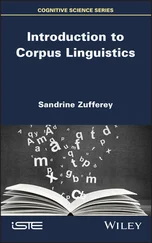Word meaning
177
from ewe in the same way as does bull from cow and stallion from mare is now explicated: the distinction in each case comes down to the presence of [male] or
[female] in the representation of the words’ meanings.
Next, consider the relationship between ram and ewe, on the one hand, and
lamb on the other. We haven’t offered a name for this semantic relationship, but this doesn’t matter, since all we need to recognise is that it is the same relationship as that obtaining between the pair bull and cow and the single word calf, and of course this observation can be extended to the items in (164c). Again, then, we can propose a two-valued ‘maturity’ feature with values [adult] and [non-adult], with the former being part of the meaning of ram, ewe, bull, cow, stallion and mare and the latter part of the meaning of lamb, calf and foal. Proceeding in this fashion, then, we can begin to build up representations of the meanings of our lexical items, as indicated for the ovine members of (164) in (165):
(165) a.
ram – [male, adult, …]
b.
ewe – [female, adult, …]
c.
lamb – [non-adult, …]
In (165c), lamb does not of course have either [male] or [female] in its semantic representation, as it is not gender-specific. There are a number of reasons why this general programme might be attractive.
Firstly, it establishes important correspondences between the semantic representations of words and the phonological representations of sounds. It will be recalled from section 5 that distinctive phonological features have the role of distinguishing the sounds in a language and that the same feature distinguishes distinct pairs of sounds. Thus, the feature [±voiced] underlies the distinction between /p/ and /b/, /t/ and /d/, /k/ and /g/, /s/ and /z/, etc. Here, we are considering something entirely analogous in the domain of word meaning: the feature [male]/
[female] underlies the distinction between the meanings of ram and ewe, bull and cow, stallion and mare, etc.
A second attraction is that we appear to be provided with an understanding of semantic relations such as antonymy, complementarity and hyponymy. Taking the two types of opposites, it is not unreasonable to suppose that feature analysis will uncover a small number of binary features which can be regarded as underlying all opposites. Consider again dimensional adjectives. Obviously, we will need some way of distinguishing tall and short as a pair from wide and narrow as a pair, but within each pair all we need to note is that one member ascribes more than average extent along a dimension, whereas the other ascribes less than average extent along that same dimension; a tall child is taller than the average child (of that age), a narrow road is narrower than the average road (of that type), etc. We can code this as a feature, say [±Average], and offer the partial analyses in (166): (166) a.
tall – [+Average, …]
b.
short – [−Average, …]
c.
wide – [+Average, …]
d.
narrow – [−Average, …]
178
words
Pairs of complementaries will employ other oppositely valued features and the logical properties of antonyms which distinguish them from complementaries
(recall the contrast between 160 and 163) will be ultimately explained in terms of the difference between these features and [±Average].
As for hyponymy, the label ‘meaning inclusion’ gives an immediate clue
as to how this should be handled. If we consider a pair such as snake and
reptile, we might suppose that we have the analysis in (167) for the meaning of the latter:
(167)
reptile – [F1, F2, …, Fn]
Obviously, we have not done the analysis, but it is easy enough to think of
candidates such as [animate] and [cold-blooded] for the sorts of features we might need. With (167) in place, then, the meaning of snake will have an analysis along the lines of (168):
(168)
snake – [F1, F2, … Fn, Fn+1, …, Fm]
In (168), we see the features F1, F2, …, Fn corresponding to the meaning of reptile – the meaning of reptile is actually included in the meaning of snake.
Additionally, however, we have the features Fn+1, …, Fm, and these features will serve to distinguish the meaning of snake from the meanings of other words
denoting reptiles.
Finally, there is something inherently appealing about the idea that meanings can be decomposed into more basic parts. If something along these lines is not correct, it is very unclear what a theory of word meaning might look like
(exercise 10).
Despite the positive views we have just sketched, there are a number of
difficulties which the supporter of semantic features must face. We can raise one of these in the context of the partial analyses we have presented in (165) and (166). Take (165) first. What we have there is sufficient to distinguish the meanings of ram, ewe and lamb from each other. However, we have done nothing to
distinguish this set of items from the sets in (164b, c). In terms of the semantic features we introduced above, the three items in (164b) will receive exactly the same analysis as we have in (165) and the same goes for the three items in (164c).
Of course, this incompleteness is acknowledged by the dots in (165), but this ought not to disguise the fact that in a complete account something must replace the dots. What might that be?
We can observe that the semantic relationship between lamb and calf is
identical to both the semantic relationship between ram and bull and that between ewe and cow. Using the methodology we adopted above, we can propose a feature with values [ovine] and [bovine] as underlying this relationship. Consideration of the set of words in (164c) requires that this feature also takes the value [equine], and then we can offer an analysis like that in (169) which could be extended to our full set of items in an obvious way:
Word meaning
179
(169)
ram – [male, adult, ovine]
There is nothing to object to here from a formal perspective, but we are unlikely to feel as comfortable with [ovine], [bovine] and [equine] as we are with our earlier features, which brought with them an air of ‘basicness’ and the belief that they would find wide employment in the analysis of word meanings in any language. By contrast, our new feature will find no role outside the very restricted domain which led to its introduction. Furthermore, consideration of additional species is just going to lead to a proliferation of feature values, and we might begin to suspect that our feature vocabulary is going to end up not much smaller than the set of words the meanings of which we set out to account for.
This pessimism is reinforced by considering (166) in a similar way. Again, our analysis is incomplete, and in order to complete it, we will have to introduce features which distinguish tall and short from wide and narrow. In itself, this may seem easy; after all, tall and short are concerned with vertical extent, whereas wide and narrow refer to extent in horizontal dimensions. So, we could introduce a feature with values [vertical] and [horizontal] and add these values to (166) to yield a complete analysis – note that this makes explicit that tall and short are indeed similar in meaning. Now, [vertical] and [horizontal] don’t have the
uncomfortable specificity of [ovine], but a little more reflection suggests that something equally worrying is not too far away if we pursue an analysis of
dimensional adjectives along these lines. For instance, consider the antonymic pair high and low. Like tall and short, these two words refer to extent along the vertical dimension, so at least one additional feature is going to be necessary to distinguish these pairs. But it is not at all clear what this feature might be (see
Читать дальше
![Andrew Radford Linguistics An Introduction [Second Edition] обложка книги](/books/397851/andrew-radford-linguistics-an-introduction-second-cover.webp)











